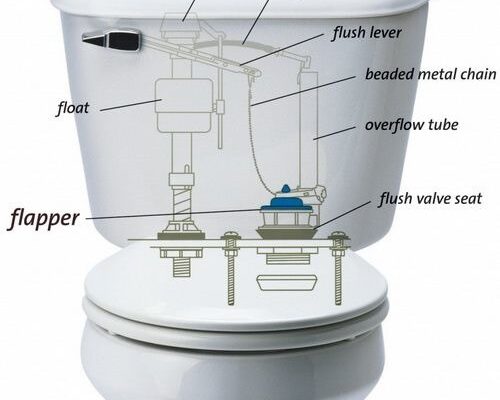This comprehensive diagram provides an in-depth look at the internal mechanisms of a standard gravity-flush toilet tank, meticulously labeling each key component and revealing the intricate interplay that governs the flushing and refilling processes. Understanding these parts is crucial for homeowners, plumbers, and anyone interested in the basic mechanics of a common household fixture.
At the heart of the system is the tank, a porcelain or plastic reservoir designed to hold a specific volume of water necessary for effectively flushing waste from the toilet bowl. The diagram presents a cutaway view, allowing us to peer inside and examine the various components that reside within this seemingly simple container.
The fill valve, typically located on the left side of the tank, is the gatekeeper of the water supply. It’s responsible for replenishing the water expelled during a flush. This valve operates based on the position of the float, a buoyant device tethered to the valve mechanism. As the water level drops after a flush, the float descends, opening the fill valve and allowing fresh water to enter the tank. Conversely, as the tank refills, the rising water lifts the float, eventually reaching a predetermined level that triggers the fill valve to shut off the water supply, preventing overflow. The fill valve often incorporates an adjustment mechanism to control the water level in the tank, influencing the force of the flush.
Connected to the fill valve is the refill tube, a slender, flexible conduit that plays a vital role in maintaining the correct water level within the toilet bowl itself. After the flapper lifts and water rushes into the bowl, the water level in the bowl decreases. The refill tube directs a small stream of water from the fill valve, bypassing the main tank outlet, and flows down the overflow tube into the bowl. This ensures that the bowl refills to the appropriate level, creating a water seal that prevents foul sewer gases from escaping into the bathroom.
The initiation of the flushing cycle rests with the flush lever, a handle situated on the exterior of the tank. When the user activates this lever, it pivots an internal arm connected to the beaded metal chain. This chain, in turn, is attached to the flapper, the crucial seal at the bottom of the tank. The leverage exerted by the flush lever lifts the flapper off the flush valve seat, the circular opening that forms the exit point for water in the tank.
The flush valve seat is a critical component, as it provides a perfectly smooth and consistent surface for the flapper to create a watertight seal when the toilet is not being flushed. Any imperfections or debris on this seat can compromise the seal, leading to a slow but persistent leak of water from the tank into the bowl, wasting water and potentially causing the fill valve to cycle intermittently.
The flapper itself is typically made of flexible rubber or silicone, designed to create a tight seal against the flush valve seat. When lifted by the chain, it allows the entire volume of water in the tank to surge into the toilet bowl, carrying away waste. The design of the flapper, including its size and buoyancy, influences the duration and force of the flush. Some flappers have adjustable features to control the amount of water used per flush.
Finally, the overflow tube acts as a critical safety mechanism, preventing the toilet tank from overflowing in the event of a fill valve malfunction. If the fill valve fails to shut off the water supply, the rising water level will eventually reach the top of the overflow tube and drain harmlessly into the toilet bowl, rather than spilling onto the bathroom floor. The refill tube is strategically positioned to discharge into the overflow tube, ensuring that the bowl is refilled through this controlled pathway.
In essence, the seemingly simple act of flushing a toilet is a coordinated sequence orchestrated by these interconnected components. The fill valve replenishes the water, the flush lever initiates the release via the flapper, and the overflow tube stands guard against overfilling. Understanding the function of each part not only demystifies the process but also empowers homeowners to diagnose and potentially resolve common toilet issues, contributing to water conservation and efficient plumbing maintenance.



